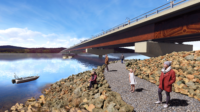Alaska is rethinking the “bridge to nowhere.”
Officials of the state are re-evaluating options for a multi-million dollar span that would link Ketchikan to the city’s airport on thinly populated Gravina Island. Omaha-based HDR Inc. is working on different options.
Last year Congress earmarked $233 million to build the bridge and the allocation drew national criticism and the Gravina Island crossing earned its nickname. The engineering wonder was slated to be a mile long, nearly the length of the Golden Gate Bridge and some 80 feet taller than the Brooklyn Bridge. After the outcry, Congress said the funding did not have to used for the bridge, but could be dispersed at the discretion of Alaskan officials.
|
“The fact is there isn’t a great deal of funding going around right now so we’re looking at other alternatives,” says James A. Lowell, construction group chief for the Alaska Department of Transportation. The agency has decided to allocate part of the federal funds to the bridge and put the rest of the money toward other state projects. About $133 million is currently available for the bridge, according to the DOT.
Lowell says that the department is re-examining a handful of lower-cost designs originally put forth in the 2004 environmental impact statement. The schemes have pricetags in the range of $200 million to $280 million.
The final EIS included 18 different schemes. Lowell says DOT is looking into at least four of those. One is a two-span bridge similar in design to the original controversy-causing link, but with modifications he says would save money. Two other options involve single-span bridges and new siting. They would cross the Tongass Narrows—a high-volume waterway about 13 nautical miles long--between Gravina and Ketchikan at points that would require shorter bridge spans and less road construction. Lowell says DOT is also looking at a submerged tube tunnel. It would also cross the narrows at the shortest possible expanse. DOT hired HDR to work on the bridge project in 1999 and it will continue as a consulting engineer. Lowell could not offer specific cost details. “We’re in the information-collection mode at this point in terms of costs and alternatives,” he says.
DOT officials say the agency will present new options during a series of public meetings in Ketchikan this month. City of Ketchikan Mayor Bob Weinstein says he’s disappointed DOT is capping costs on the bridge, but not an even more costly construction and engineering project in nearby Juneau. The Juneau Access project is a 50-mile road with a likely $250-million budget. It would stretch north of Juneau to the Katzehin River, where car ferries would take passengers to the state’s highway system. “Ask the DOT why they’re not looking at alternatives for the Juneau Access project,” Weinstein says.
Alaskans will elect a new governor in November and their choice could significantly impact both projects.
 Related Links:
Related Links: 


Post a comment to this article
Report Abusive Comment